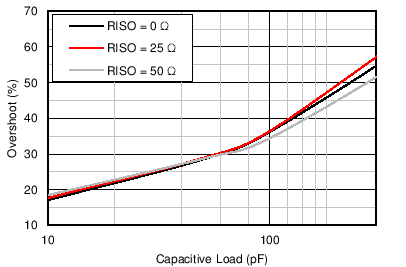SBOS807E December 2016 – May 2020 OPA187 , OPA2187 , OPA4187
UNLESS OTHERWISE NOTED, this document contains PRODUCTION DATA.
- 1 Features
- 2 Applications
- 3 Description
- 4 Revision History
- 5 Pin Configuration and Functions
-
6 Specifications
- 6.1 Absolute Maximum Ratings
- 6.2 ESD Ratings
- 6.3 Recommended Operating Conditions
- 6.4 Thermal Information: OPA187
- 6.5 Thermal Information: OPA2187
- 6.6 Thermal Information: OPA4187
- 6.7 Electrical Characteristics: High-Voltage Operation
- 6.8 Electrical Characteristics: Low-Voltage Operation
- 6.9 Typical Characteristics
- 7 Detailed Description
- 8 Application and Implementation
- 9 Power Supply Recommendations
- 10Layout
- 11Device and Documentation Support
- 12Mechanical, Packaging, and Orderable Information
Package Options
Mechanical Data (Package|Pins)
Thermal pad, mechanical data (Package|Pins)
Orderable Information
7.3.6 Capacitive Load and Stability
The dynamic characteristics of the OPAx187 are optimized for a range of common operating conditions. The combination of low closed-loop gain and high capacitive loads decreases the amplifier phase margin and can lead to gain peaking or oscillations. As a result, larger capacitive loads must be isolated from the output. The simplest way to achieve this isolation is to add a small resistor (for example, ROUT equal to 50 Ω) in series with the output. Figure 38 illustrates small-signal overshoot versus capacitive load for several values of ROUT. Also, for details of analysis techniques and application circuits, refer to the Feedback Plots Define Op Amp AC Performance application report, available for download from www.ti.com.

| G = 1, RL = 10 kΩ, 10-mV Output Step |